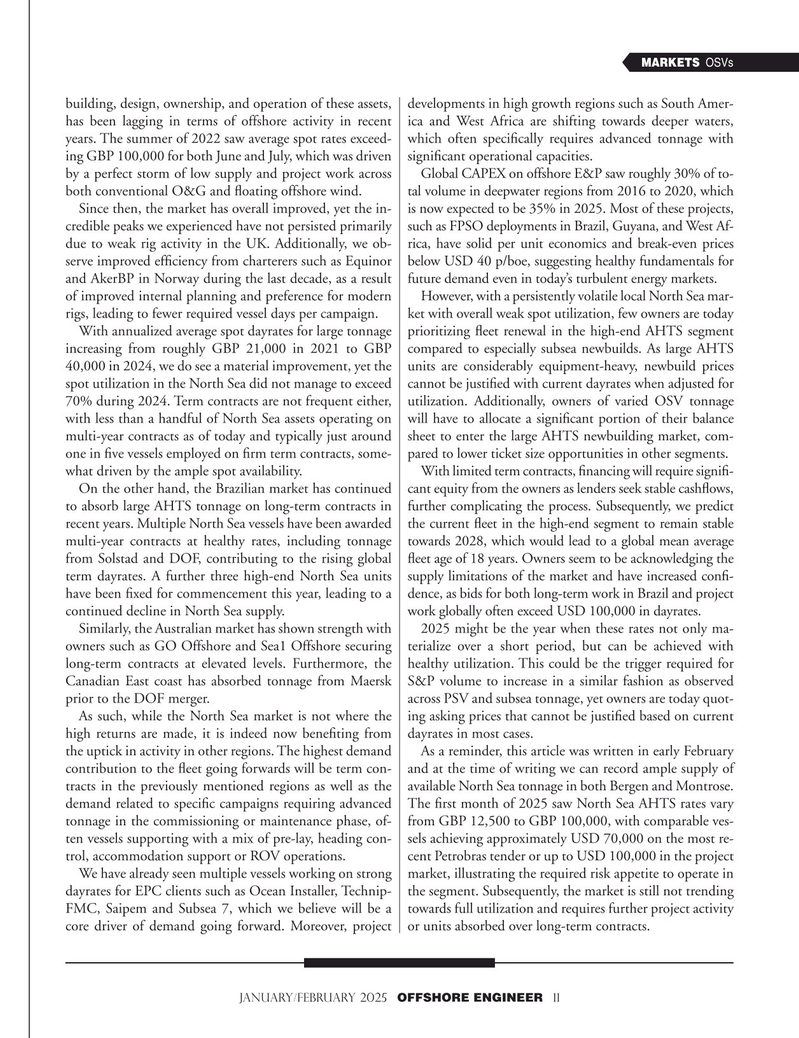
Page 11: of Offshore Engineer Magazine (Jan/Feb 2025)
Read this page in Pdf, Flash or Html5 edition of Jan/Feb 2025 Offshore Engineer Magazine
MARKETS OSVs building, design, ownership, and operation of these assets, developments in high growth regions such as South Amer- has been lagging in terms of offshore activity in recent ica and West Africa are shifting towards deeper waters, years. The summer of 2022 saw average spot rates exceed- which often speci?cally requires advanced tonnage with ing GBP 100,000 for both June and July, which was driven signi?cant operational capacities. by a perfect storm of low supply and project work across Global CAPEX on offshore E&P saw roughly 30% of to- both conventional O&G and ?oating offshore wind. tal volume in deepwater regions from 2016 to 2020, which
Since then, the market has overall improved, yet the in- is now expected to be 35% in 2025. Most of these projects, credible peaks we experienced have not persisted primarily such as FPSO deployments in Brazil, Guyana, and West Af- due to weak rig activity in the UK. Additionally, we ob- rica, have solid per unit economics and break-even prices serve improved ef?ciency from charterers such as Equinor below USD 40 p/boe, suggesting healthy fundamentals for and AkerBP in Norway during the last decade, as a result future demand even in today’s turbulent energy markets. of improved internal planning and preference for modern However, with a persistently volatile local North Sea mar- rigs, leading to fewer required vessel days per campaign. ket with overall weak spot utilization, few owners are today
With annualized average spot dayrates for large tonnage prioritizing ?eet renewal in the high-end AHTS segment increasing from roughly GBP 21,000 in 2021 to GBP compared to especially subsea newbuilds. As large AHTS 40,000 in 2024, we do see a material improvement, yet the units are considerably equipment-heavy, newbuild prices spot utilization in the North Sea did not manage to exceed cannot be justi?ed with current dayrates when adjusted for 70% during 2024. Term contracts are not frequent either, utilization. Additionally, owners of varied OSV tonnage with less than a handful of North Sea assets operating on will have to allocate a signi?cant portion of their balance multi-year contracts as of today and typically just around sheet to enter the large AHTS newbuilding market, com- one in ?ve vessels employed on ?rm term contracts, some- pared to lower ticket size opportunities in other segments. what driven by the ample spot availability. With limited term contracts, ?nancing will require signi?-
On the other hand, the Brazilian market has continued cant equity from the owners as lenders seek stable cash?ows, to absorb large AHTS tonnage on long-term contracts in further complicating the process. Subsequently, we predict recent years. Multiple North Sea vessels have been awarded the current ?eet in the high-end segment to remain stable multi-year contracts at healthy rates, including tonnage towards 2028, which would lead to a global mean average from Solstad and DOF, contributing to the rising global ?eet age of 18 years. Owners seem to be acknowledging the term dayrates. A further three high-end North Sea units supply limitations of the market and have increased con?- have been ?xed for commencement this year, leading to a dence, as bids for both long-term work in Brazil and project continued decline in North Sea supply. work globally often exceed USD 100,000 in dayrates.
Similarly, the Australian market has shown strength with 2025 might be the year when these rates not only ma- owners such as GO Offshore and Sea1 Offshore securing terialize over a short period, but can be achieved with long-term contracts at elevated levels. Furthermore, the healthy utilization. This could be the trigger required for
Canadian East coast has absorbed tonnage from Maersk S&P volume to increase in a similar fashion as observed prior to the DOF merger. across PSV and subsea tonnage, yet owners are today quot-
As such, while the North Sea market is not where the ing asking prices that cannot be justi?ed based on current high returns are made, it is indeed now bene?ting from dayrates in most cases. the uptick in activity in other regions. The highest demand As a reminder, this article was written in early February contribution to the ?eet going forwards will be term con- and at the time of writing we can record ample supply of tracts in the previously mentioned regions as well as the available North Sea tonnage in both Bergen and Montrose. demand related to speci?c campaigns requiring advanced The ?rst month of 2025 saw North Sea AHTS rates vary tonnage in the commissioning or maintenance phase, of- from GBP 12,500 to GBP 100,000, with comparable ves- ten vessels supporting with a mix of pre-lay, heading con- sels achieving approximately USD 70,000 on the most re- trol, accommodation support or ROV operations. cent Petrobras tender or up to USD 100,000 in the project
We have already seen multiple vessels working on strong market, illustrating the required risk appetite to operate in dayrates for EPC clients such as Ocean Installer, Technip- the segment. Subsequently, the market is still not trending
FMC, Saipem and Subsea 7, which we believe will be a towards full utilization and requires further project activity core driver of demand going forward. Moreover, project or units absorbed over long-term contracts. january/february 2025 OFFSHORE ENGINEER 11

 10
10

 12
12